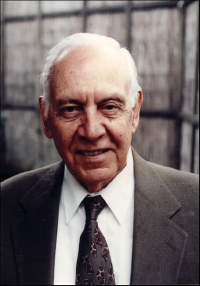
Peter A. Sturrock (b. England, 1924) studied mathematics at Cambridge University from 1942 until 1949, with a three-year interruption (1943-46) to carry out countermeasures research at the Telecommunications Research Establishment (TRE), now the Royal Radar Establishment (RRE). He was elected to a scholarship at St John's College in 1947, was awarded the University Rayleigh Prize for mathematics in 1949, and was elected to a fellowship at St John's in 1952. Research work on electron physics carried out at the Cavendish Laboratory, Cambridge University, the National Bureau of Standards in Washington (1949-50), and the Ecole Normale Superieure at the University of Paris (CNRS Fellow, 1950-51), earned him a Ph.D. in 1951. His Ph.D. dissertation was later expanded and published as a monograph entitled Static and Dynamic Electron Optics in 1955.
Sturrock subsequently pursued research in nuclear physics as Harwell Research Fellow at the Atomic Energy Research Establishment, England (1951-53); research on plasma physics as Fellow of St. Johns' College, Cambridge (1953-55); research on microwave tubes as Research Associate in the Microwave Laboratory at Stanford University (1955-58, 1959-60); and research on accelerator physics as Ford Foundation Fellow at the European Center for Nuclear Research (CERN), Geneva (1958-59). During this period, Sturrock made a number of inventions, one of them being a microwave tube that operates on a principle subsequently named the "free-electron laser."
Sturrock was appointed Professor of Engineering Science and Applied Physics in the School of Engineering and the Physics Department at Stanford University in January 1961, and is currently Professor of Space Science and Astrophysics in the Applied Physics Department and, by courtesy, in the Physics Department. Sturrock was Chair of the Founding Committee of the Institute for Plasma Research and served as Director from 1964-74 and from 1980-83. He subsequently served (in 1982-83) as Chair of the Founding Committee of the Center for Space Science and Astrophysics and served as Deputy Director from 1983-92 and as Director from 1992 to the present. He also served as Chair of the committees that established (in 1983) the Stanford-NASA-Ames Institute for Space Research, and (in 1986) the Stanford-Lockheed Institute for Astrophysical and Space Research. Since 1961, he has worked primarily on plasma physics, solar physics and astrophysics, but takes an interest also in scientific inference and in the history and philosophy of science. He has published over two hundred scientific articles and two monographs, and has edited five volumes that review plasma physics, solar physics and astrophysics. His most recent monograph, Plasma Physics, an Introduction to the Theory of Astrophysical, Geophysical and Laboratory Plasmas, is a textbook on plasma physics based on a graduate level course that he has taught at Stanford for over twenty years. It is the first book to be published as part of the new Cambridge-Stanford textbook series.
From 1965-66, Sturrock served as Chairman of the Division of Plasma Physics of the American Physical Society, and from 1974-75 as Chairman of the Solar Physics Division of the American Astronomical Society. He was Director of the Summer School on Plasma Astrophysics at Varenna, Italy, in 1966; Chairman of the Organizing Committee of the Conference on Plasma Instabilities in Astrophysics held at Asilomar in 1968; and Director of the Skylab Workshop on Solar Flares held at Boulder in 1977. He has also served on many national panels and committees, notably (1984-85) as Chairman of the Advocacy Panel that reviewed Solar Physics for the National Academy of Sciences.
Sturrock is a member of the American Astronomical Society, the American Institute of Aeronautics and Astronautics, the International Academy of Astronautics, and the International Astronomical Union, and is a Fellow of the American Association for the Advancement of Science, the American Physical Society, and the Royal Astronomical Society. Sturrock's interests in the role of anomalies in the progress of science led him to chair the Founding Committee of the Society for Scientific Exploration and since 1982 he has served as President of the Society that now has over 500 members worldwide and publishes a quarterly journal. In 1967, Sturrock received the Gravity Prize (for gravitational research) from the Gravity Research Foundation; in 1977, the Lindsay Award from NASA Goddard Space Flight Center; in 1986 the Hale Prize for solar physics from the American Astronomical Society; in 1990, the Arctowski Medal for solar-terrestrial research from the National Academy of Sciences; and in 1992, the Space Sciences Award from the American Institute of Aeronautics and Astronautics.







